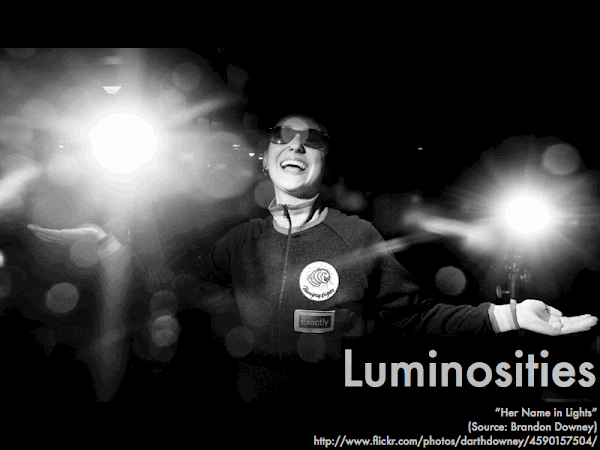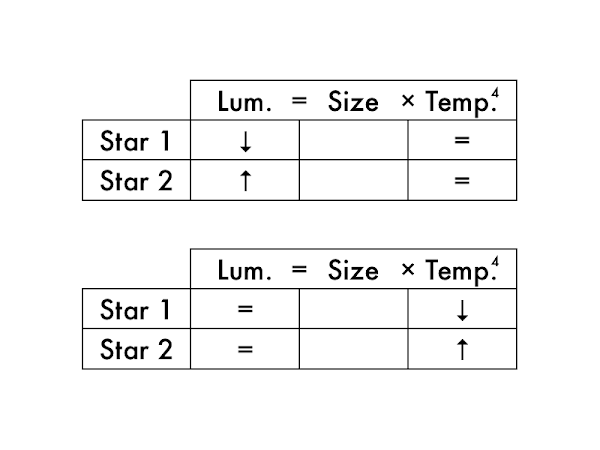Cuesta College, San Luis Obispo, CA
Students have a weekly online reading assignment (hosted by SurveyMonkey.com), where they answer questions based on reading their textbook, material covered in previous lectures, opinion questions, and/or asking (anonymous) questions or making (anonymous) comments. Full credit is given for completing the online reading assignment before next week's lecture, regardless if whether their answers are correct/incorrect. Selected results/questions/comments are addressed by the instructor at the start of the following lecture.
The following questions were asked on reading textbook chapters and previewing presentations on parallax, distance, apparent magnitude, absolute magnitude, Wien's law and the Stefan-Boltzmann law.

Selected/edited responses are given below.
Describe something you found interesting from the assigned textbook reading or presentation preview, and explain why this was personally interesting for you.
"Parallax--the shift in perspective can actually tell you more about the star. Like if the star is close it has a large parallax and a far star has a small parallax."
"That a dimmer star has a bigger positive magnitude number--I would assume it would be the other way around."
"That the light year unit can be used interchangeably with parsecs. I hadn't known the amount of light years that are in a parsec until now. 1 parsec = 3.26 light years. Also that our sun is hotter than the star Betelgeuse."
"That we can tell the temperature of a star based upon the color it gives off."
Describe something you found confusing from the assigned textbook reading or presentation preview, and explain why this was personally confusing for you.
"Absolute magnitude and luminosity measurements were confusing but anything involving math is confusing to me."
"Parsecs--I understand that it is the distance in the shift but not how the calculation works out."
"The brightness scale. I know I am going to mix it up with –1 being brighter than +6! This is confusing because I just think positive would mean brighter."
"The H-R diagram."
"Luminosity confuses me. How does luminosity affect or help us figure out star size?"
Explain how apparent magnitude and the absolute magnitude are defined differently.
"Absolute is the brightness a star would give if 10 parsec away. While apparent is what it looks like from a distance and not the true brightness."
"Well, apparent magnitude is the as is brightness as seen by observers on Earth, however its not a fair judge because of distance. On the other hand, absolute magnitude levels the playing field providing a new way to compare the actual brightness of stars with each other."
"Apparent magnitude is the 'as is' brightness as sen by an observer on Earth, without compensating for distance. Absolute magnitude is the 'actual brightness' of stars once the distances are known."
"Apparent is what we see, and absolute is what really is."
"Apparent magnitude (lower case 'm') does not compensate for distance, so the star is seen 'as is' when observed from earth. Absolute magnitude (capital 'M') calculates brightness when placing stars 10 parsecs away from each other and becomes a way to compare actual brightness."
Suppose the sun was moved to a distance of 10 parsecs away. As a result, its __________ magnitude would become dimmer.
absolute. [7] apparent. [17] (Both of the above choices.) [2] (Neither of the above choices.) [1] (Unsure/guessing/lost/help!) [2]

(Only correct responses shown.)
1 (brightest): the sun, m = –27 [72%]
2: Canopus, m = –1 [66%]
3: Vega, m = 0 [62%]
4 (dimmest): Kapteyn's star, m = +9 [72%]
Rank the brightnesses of these stars (1 = brightest, 4 = dimmest; there are no ties), if relocated to 10 parsecs from Earth.
(Only correct responses shown.)
1 (brightest): Canopus, M = –3 [62%]
2: Vega, M = +0.5 [72%]
3: the sun, M = +5 [55%]
4 (dimmest): Kapteyn's star, M = +11 [83%]
Determine whether these stars get dimmer or brighter when relocated from their original positions to 10 parsecs from Earth.
(Only correct responses shown.)
The sun: gets dimmer [62%]
Canopus: gets brighter [66%]
Vega: gets dimmer [45%]
Kapteyn's star: gets dimmer [48%]
Rank the temperatures of these main sequence stars (1 = hottest, 4 = coolest; there are no ties).
(Only correct responses shown.)
Hottest: blue main sequence star [72%]
Second hottest: white main sequence star [65%]
Third hottest: yellow main sequence star [83%]
Coolest: red main sequence star [83%]
Rank the temperatures of these supergiant and dwarf stars (1 = hottest, 4 = coolest; there are no ties).
(Only correct responses shown.)
Hottest: blue supergiant [62%]
Second hottest: white dwarf [55%]
Third hottest: yellow supergiant [72%]
Coolest: red dwarf [79%]

dimmer. ** [2] brighter. *********************** [23] (These stars would be the same size.) [0] (Unsure/guessing/lost/help!) **** [4]
Two stars (equally far away) have the same brightness, but one star is cooler, and the other star is hotter. The __________ star will be larger in size.
cooler. ************ [12] hotter. ************ [12] (These stars would be the same size.) * [1] (Unsure/guessing/lost/help!) **** [4]
Ask the instructor an anonymous question, or make a comment. Selected questions/comments may be discussed in class.
"This section is slightly confusing in trying to determine if a star is hot/cool based on size/brightness."
"This chapter was one of the more confusing ones for me I'm not sure why. /:"
"Do we get to watch the presidential debate in class?" (Sorry, no. But we might get to see the International Space Station pass overhead tonight.)
"Can people who are color blind be astronomers?" (Yes. Yes, they can.)
No comments:
Post a Comment